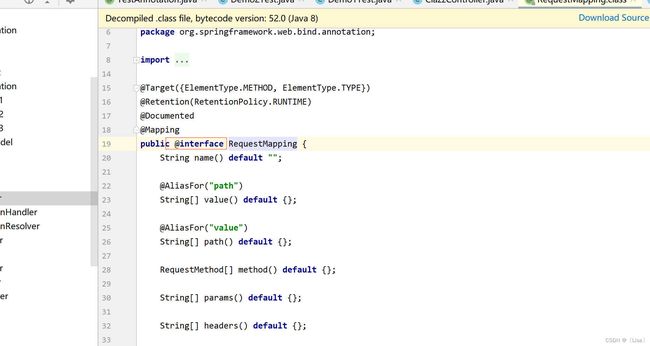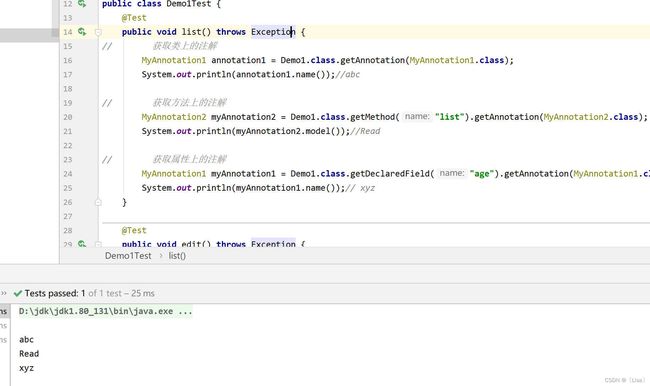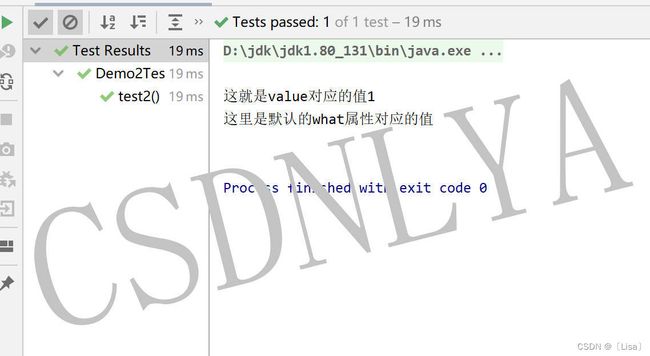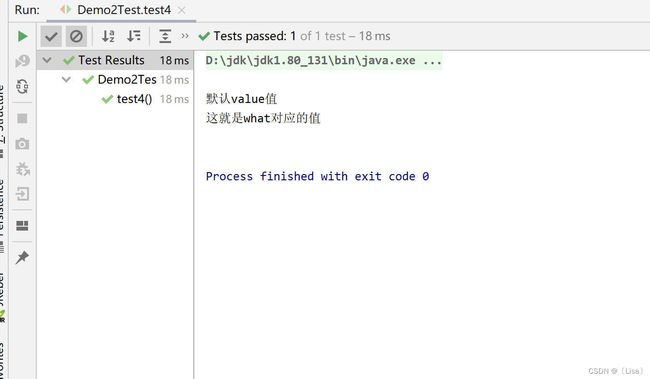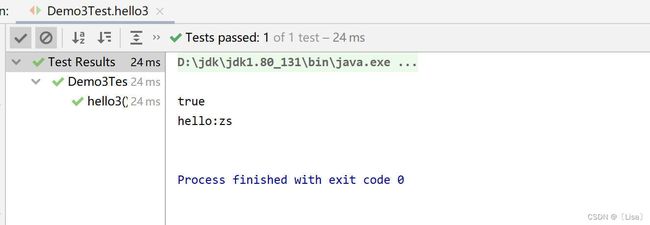SpringMVC自定义注解
目录
一,Java注解简介
1.java注解的定义
2.Java注解分类
2.1JDK基本注解
2.2JDK元注解
2.3自定义注解
二,自定义注解
如何自定义注解?
三,Aop自定义注解的应用
四,总结
一,Java注解简介
1.java注解的定义
Java注解是附加在代码中的一些元信息,用于一些工具在编译、
运行时进行解析和使用,起到说明、配置的功能。 注解相关类都
包含在java.lang.annotation包中。
2.Java注解分类
2.1JDK基本注解
@Override(重写)
@SuppressWarnings(value = "unchecked") (压制编辑器警告)
2.2JDK元注解
@Retention:定义注解的保留策略
@Retention(RetentionPolicy.SOURCE) //注解仅存在于源码中,在class字节码文件中不包含
@Retention(RetentionPolicy.CLASS) //默认的保留策略,注解会在class字节码文件中存在,但运行时无法获得,
@Retention(RetentionPolicy.RUNTIME) //注解会在class字节码文件中存在,在运行时可以通过反射获取到
@Target:指定被修饰的Annotation可以放置的位置(被修饰的目标)
@Target(ElementType.TYPE) //接口、类
@Target(ElementType.FIELD) //属性
@Target(ElementType.METHOD) //方法
@Target(ElementType.PARAMETER) //方法参数
@Target(ElementType.CONSTRUCTOR) //构造函数
@Target(ElementType.LOCAL_VARIABLE) //局部变量
@Target(ElementType.ANNOTATION_TYPE) //注解
@Target(ElementType.PACKAGE) //包
注:可以指定多个位置,例如:
@Target({ElementType.METHOD, ElementType.TYPE}),也就是此注解可以在方法和类上面使用
@Inherited:指定被修饰的Annotation将具有继承性
@Documented:指定被修饰的该Annotation可以被javadoc工具提取成文档.
2.3自定义注解
注解分类(根据Annotation是否包含成员变量,可以把Annotation分为两类):
标记Annotation:
没有成员变量的Annotation; 这种Annotation仅利用自身的存在与否来提供信息
理解:就是没有
元数据Annotation:
包含成员变量的Annotation; 它们可以接受(和提供)更多的元数据;
二,自定义注解
如何自定义注解?
使用@interface关键字, 其定义过程与定义接口非常类似, 需要注意的是:Annotation的成员变量在Annotation定义中是以无参的方法形式来声明的, 其方法名和返回值类型定义了该成员变量的名字和类型, 而且我们还可以使用default关键字为这个成员变量设定默认值
例如:SpringMVC已经定义好的:RequestMapping注解
@interface 是修饰注解类
@Target(决定自定义注解用在哪)
//ElementType.TYPE 指注解可以用在类上面
//ElementType.METHOD 指注解可以用在属性上面
//ElementType.FIELD 指用在方法上面@Retention(定义注解的保留策略)
//RetentionPolicy.SOURCE注解仅存在于源码中,在class字节码文件中不包含
//RetentionPolicy.CLASS默认的保留策略,注解会在class字节码文件中存在,但运行时无法获得
//RetentionPolicy.RUNTIME注解会在class字节码文件中存在,在运行时可以通过反射获取到
在注解类中定义的属性方法,都称为注解类的属性,我们接下来使用我们自定义的注解进行属性的使用,其中注解的属性为value时是可以省略的一般都会给一个default默认值
例如创建一个MyAnnotation1将其定义为可用在类、方法以及参数上:
package com.liyongan.annotation; import java.lang.annotation.*; /** * MyAnnotation1注解可以用在类、接口、属性、方法上 * 注解运行期也保留 * 不可继承 */ @Target({ElementType.TYPE, ElementType.FIELD,ElementType.METHOD}) @Retention(RetentionPolicy.RUNTIME) @Documented public @interface MyAnnotation1 { String name(); }MyAnnotation2:可用在方法上:
package com.liyongan.annotation; import java.lang.annotation.*; /** * MyAnnotation2注解可以用在方法上 * 注解运行期也保留 * 不可继承 */ @Target(ElementType.METHOD) @Retention(RetentionPolicy.RUNTIME) @Documented public @interface MyAnnotation2 { TranscationModel model() default TranscationModel.ReadWrite; }MyAnnotation3:注解可以用在方法上,相比较MyAnnotation2多了一个注解@Inherited(可继承)
package com.liyongan.annotation; import java.lang.annotation.*; /** * MyAnnotation3注解可以用在方法上 * 注解运行期也保留 * 可继承 */ @Target(ElementType.METHOD) @Retention(RetentionPolicy.RUNTIME) @Inherited @Documented public @interface MyAnnotation3 { TranscationModel[] models() default TranscationModel.ReadWrite; }测试类:
Demo1测试类:
package com.liyongan.annotation.demo1; import com.liyongan.annotation.MyAnnotation1; import com.liyongan.annotation.MyAnnotation2; import com.liyongan.annotation.MyAnnotation3; import com.liyongan.annotation.TranscationModel; /** * 获取类与方法上的注解值 */ @MyAnnotation1(name = "abc") public class Demo1 { @MyAnnotation1(name = "xyz") private Integer age; @MyAnnotation2(model = TranscationModel.Read) public void list() { System.out.println("list"); } @MyAnnotation3(models = {TranscationModel.Read, TranscationModel.Write}) public void edit() { System.out.println("edit"); } }Demo1Test:
package com.liyongan.annotation.demo1; import com.liyongan.annotation.MyAnnotation1; import com.liyongan.annotation.MyAnnotation2; import com.liyongan.annotation.MyAnnotation3; import com.liyongan.annotation.TranscationModel; import org.junit.jupiter.api.Test; /** */ public class Demo1Test { @Test public void list() throws Exception { // 获取类上的注解 MyAnnotation1 annotation1 = Demo1.class.getAnnotation(MyAnnotation1.class); System.out.println(annotation1.name());//abc // 获取方法上的注解 MyAnnotation2 myAnnotation2 = Demo1.class.getMethod("list").getAnnotation(MyAnnotation2.class); System.out.println(myAnnotation2.model());//Read // 获取属性上的注解 MyAnnotation1 myAnnotation1 = Demo1.class.getDeclaredField("age").getAnnotation(MyAnnotation1.class); System.out.println(myAnnotation1.name());// xyz } @Test public void edit() throws Exception { MyAnnotation3 myAnnotation3 = Demo1.class.getMethod("edit").getAnnotation(MyAnnotation3.class); for (TranscationModel model : myAnnotation3.models()) { System.out.println(model);//Read,Write } } } Demo1目的:我们用来获取类注释上的类与方法上的注解值:
运行list方法结果:
Demo2目的:我们用来展示获取类属性上的注解属性值 :
Demo2测试类:
package com.liyongan.annotation.demo2; import com.liyongan.annotation.demo1.TestAnnotation; /** * 获取类属性上的注解属性值 */ public class Demo2 { @TestAnnotation(value = "这就是value对应的值_msg1", what = "这就是what对应的值_msg1") private static String msg1; @TestAnnotation("这就是value对应的值1") private static String msg2; @TestAnnotation(value = "这就是value对应的值2") private static String msg3; @TestAnnotation(what = "这就是what对应的值") private static String msg4; }Demo2Test:
package com.liyongan.annotation.demo2; import org.junit.jupiter.api.Test; public class Demo2Test { @Test public void test1() throws Exception { TestAnnotation msg1 = Demo2.class.getDeclaredField("msg1").getAnnotation(TestAnnotation.class); System.out.println(msg1.value()); System.out.println(msg1.what()); } @Test public void test2() throws Exception{ TestAnnotation msg2 = Demo2.class.getDeclaredField("msg2").getAnnotation(TestAnnotation.class); System.out.println(msg2.value()); System.out.println(msg2.what()); } @Test public void test3() throws Exception{ TestAnnotation msg3 = Demo2.class.getDeclaredField("msg3").getAnnotation(TestAnnotation.class); System.out.println(msg3.value()); System.out.println(msg3.what()); } @Test public void test4() throws Exception{ TestAnnotation msg4 = Demo2.class.getDeclaredField("msg4").getAnnotation(TestAnnotation.class); System.out.println(msg4.value()); System.out.println(msg4.what()); } }运行test1方法结果:
运行test2方法结果:
运行test3方法结果:
运行test4方法结果:
Demo3目的:我们用来展示获得获得属性上自定义注释中的内容:
Demo3测试类:
public class Demo3 { public void hello1(@IsNotNull(true) String name) { System.out.println("hello:" + name); } public void hello2(@IsNotNull String name) { System.out.println("hello:" + name); } }IsNotNull:
package com.liyongan.annotation.demo3; import com.liyongan.annotation.demo3.Demo3; import java.lang.annotation.*; import java.lang.reflect.Method; import java.lang.reflect.Parameter; /** * 非空注解:使用在方法的参数上,false表示此参数可以为空,true不能为空 */ @Documented @Target({ElementType.PARAMETER}) @Retention(RetentionPolicy.RUNTIME) public @interface IsNotNull { boolean value() default false; }Demo3Test:
public class Demo3Test { @Test public void hello1() throws Exception { Demo3 demo3 = new Demo3(); for (Parameter parameter : demo3.getClass().getMethod("hello1", String.class).getParameters()) { IsNotNull annotation = parameter.getAnnotation(IsNotNull.class); if(annotation != null){ System.out.println(annotation.value());//true } } } @Test public void hello2() throws Exception { Demo3 demo3 = new Demo3(); for (Parameter parameter : demo3.getClass().getMethod("hello2", String.class).getParameters()) { IsNotNull annotation = parameter.getAnnotation(IsNotNull.class); if(annotation != null){ System.out.println(annotation.value());//false } } } @Test public void hello3() throws Exception { // 模拟浏览器传递到后台的参数 解读@requestParam String name = "zs"; Demo3 demo3 = new Demo3(); Method method = demo3.getClass().getMethod("hello1", String.class); for (Parameter parameter : method.getParameters()) { IsNotNull annotation = parameter.getAnnotation(IsNotNull.class); if(annotation != null){ System.out.println(annotation.value());//true if (annotation.value() && !"".equals(name)){ method.invoke(demo3,name); } } } } }运行test1方法结果:
运行test2方法结果:
运行test3方法结果:
三,Aop自定义注解的应用
MyLog自定义注解类
@Target(ElementType.METHOD)
@Retention(RetentionPolicy.RUNTIME)
public @interface MyLog {
String desc();
}MyLogAspect切面类
@Component
@Aspect
public class MyLogAspect {
private static final Logger logger = LoggerFactory.getLogger(MyLogAspect.class);
@Pointcut("@annotation(com.liyongan.annotation.aop.MyLog)")
private void MyValid() {
}
@Before("MyValid()")
public void before(JoinPoint joinPoint) {
MethodSignature signature = (MethodSignature) joinPoint.getSignature();
logger.debug("[" + signature.getName() + " : start.....]");
System.out.println("[" + signature.getName() + " : start.....]");
MyLog myLog = signature.getMethod().getAnnotation(MyLog.class);
logger.debug("【目标对象方法被调用时候产生的日志,记录到日志表中】:"+myLog.desc());
System.out.println("【目标对象方法被调用时候产生的日志,记录到日志表中】:" + myLog.desc());
}
}Controller层
@Controller
public class LogController {
@RequestMapping("/mylog")
@MyLog(desc = "这是结合spring aop知识,讲解自定义注解应用的一个案例")
public void testLogAspect(){
System.out.println("Tomcat运行乱码解决了!!!!");
}
}运行结果:
我们所编写的自定义注解类就可以走切面类。
四,总结
自定义注解可以用于多种场景。比如,我们可以创建一个自定义注解来限制请求的访问权限,或者用于数据验证、日志记录等。为了定义自定义注解,我们需要使用Java的
@interface关键字,它表明我们正在定义一个注解。注解中可以定义属性,在使用注解时可以设置这些属性的值。在Spring MVC中,我们可以自定义注解并将其应用到控制器的处理方法上,以实现某些特定的功能。比如,我们可以定义一个自定义的权限注解,来限制用户访问某个特定的处理方法。我们可以通过在注解中定义相关属性,如角色名称、权限级别等,然后在控制器方法上使用该注解。

